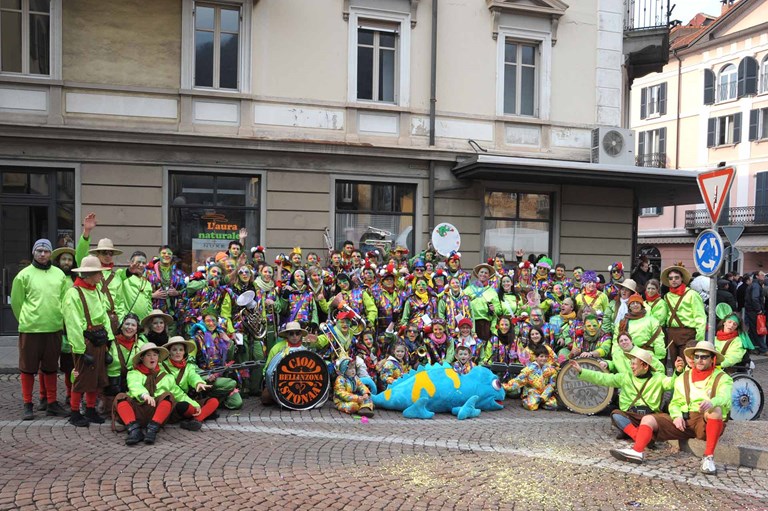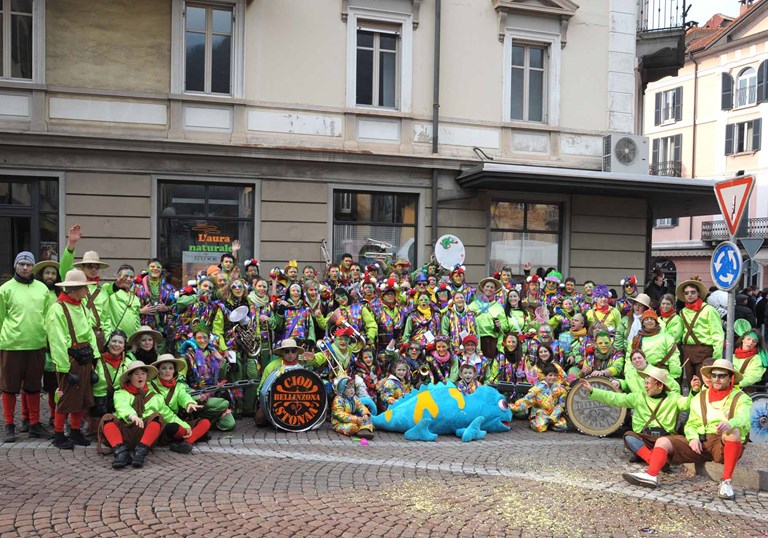
Masked music
The Rabadan, the Bellinzona Carnival, celebrated its 160th anniversary this year. Among the characteristic elements of the festivities, together with masks and floats, have long been the Guggenmusik, colourful brass and percussion bands whose rhythm helps to get the masked people dancing. Although they represent a goliardic approach to playing together, behind those performances there is organisation and work made up of musical rehearsals and tailoring skills that begins months beforehand. To find out what lies behind the Guggen costumes and songs, we interviewed Lucas Dürr, president of the Ciod Stonaa - the oldest Guggenmusik in Canton Ticino.
How did your passion for Guggenmusik start?
“It was 1999 and a scout friend of mine had a fellow student who played in the Guggen of the Ciod Stonaa in Bellinzona. So I heard that they were looking for new recruits. I always liked Carnival and I liked music too, so I joined and learnt to play the bass drum.”
Did you already have any musical experience?
“I play the guitar for pleasure and as a boy I played the piano, but I had never played the bass drum.”
Do the other Guggen colleagues also play amateurishly?
“Yes, most only play with Ciod Stonaa. Then there is a dozen or so who also play in groups, bands or philharmonic societies and have a good musical knowledge, but most play for fun.”
How many of you are there?
“On paper we have 60 members; then for various reasons at the end there are usually about 40 of us.”
When does song preparation begin?
“We usually meet up in the last weekend in August and then continue with rehearsals every Friday evening from around 8pm to 10.30pm in Bellinzona. It is also a date to get together, to have a beer or a pizza before or after rehearsals. Some sections, particularly the wind instruments, also rehearse during the week. Then in January the performances begin. Because it is true that our spirit is goliardic and carnivalesque, but we also want to play things that are pleasant to hear.”
What kind of tracks do you have in your repertoire?
“We have about 20 songs and every year we leave three of them behind and offer three new ones. They are almost all established hits, well-known pop-rock tunes, because our motto is to entertain while having fun, which is why we choose songs and music that bring the audience to dance.”
Who chooses the pieces?
“The members make their proposals, but then it is our maestro Daniele Cavallini who ultimately decides. The maestro is a very important figure because during performances he has to have the ability to pick up the pace when it drops. Rhythm understood musically, but also as the environment of the group.”
How many performances do you do during the Carnival period?
“It depends. Let’s say that from mid-January for 6-7 weekends we are engaged in about twenty appointments in the different Carnivals and on each occasion you perform 3 or 4 times.”
Is there a generational change in the Guggen?
“As far as ours is concerned, I can say that it goes in waves in general; maybe groups of friends join or leave together. We go from 18 to 70 years old, with an average age of around 35-40 and both female and male participation. We are very transversal because what unites us is the desire to have a carnival, to have fun and to take a break from everyday life.”
Guggen is not only music but also masquerade, how do you choose and make the costumes?
“First of all, it should be mentioned that there is a seven-person committee, consisting of: myself as president; Barbara Guggiari, events manager; Joel Casada, cashier; Andrea Leoni, secretary; Michele Pedrioli, archivist; Jessica Buloncelli, programme manager and vice-president and Nancy Zaharulko, artistic committee. It is the latter commission that takes care of the costumes.”
How is the choice made?
“During the closing assembly, after Carnival, each member can bring proposals, with a minimum of documentation on the costumes and theme for the following year. The assembly votes on two. Then at the following assembly in June, prototypes of the two options are made. A vote is taken on the favourite and in the summer the committee works out the production details with the tailoring professionals.”
How much does a dress cost?
“The dress is a not inconsiderable commitment from an economic point of view. Let’s say that on average it costs around CHF 300 each, so we have outgoings of around CHF 25,000. To finance this, we have the social tax, the fees from the various Carnivals and then we organise other events during the year to self-finance ourselves.”
Your favourite costume?
“In 2019 we had a beautiful one inspired by the Carnival of Venice, although the theme was nicely titled ‘Raisins and dried figs’”.
And in 2023?
“This year the theme is ‘Love is... rebound relationship”
But we are sure that the love for Guggenmusik will always see Bellinzona’s Ciod enjoying themselves playing masked music at Rabadan.”
Lucas Dürr
Year of birth: 1980
Profession: FO Ritom SA
After studying Engineering, Lucas Dürr completed a Master’s degree in Industrial Management and Manufacturing at the ETH Zurich. He is a Project Management Professional and CFO of Ritom SA (a company owned by SBB CFF SBB & Canton Ticino). He combines his professional activities with his passion for Guggenmusik and is president of Ciod Stonaa in Bellinzona.

THE GUGGENMUSIK
Tradition has it that Guggenmusik dates back to the 16th century and to rituals to ward off winter. It was mainly practised in Southern Germany and German-speaking Switzerland. The players in these bands used masks and noisy instruments in the hope that the noise produced would drive away the spirit of winter. However, it was in the 20th century that Guggen began to have their own codified role in carnivals. In 1934, there were already several Guggen in Basel during carnival, structured with wind instruments, particularly trombones and the like, and various percussion instruments. For the Guggen, the important thing is to convey rhythm and invite people to dance.
THE CIOD STONAA
For years, the Ciod Stonaa were Ticino’s only ‘Guggenmusik’. The idea to create it was launched on 10 November 1958 at the Ristorante Teatro in Bellinzona when the then president of the Rabadan society, Renzo Apuzzo, one of the past faces of Re Rabadan, Emilio ‘Milietto’ Imperatori, a well-known cabaret performer, and Otto Schwarz, a Carnival-loving Basel man who had an upholstery shop in town, met. They thus began to look for carnival players, especially among the confederates, where Guggen were already widespread. The name of the Guggen was already ready: Ciod Stonaa (Ciod is the nickname of the inhabitants of Bellinzona). The musical debut took place with a line-up of about ten elements. In the decades that followed, the association expanded to include dozens and dozens of Bellinzonese, who, over the years, took turns enjoying themselves to the rhythm of the Guggenmusik.
Colonna sonora



